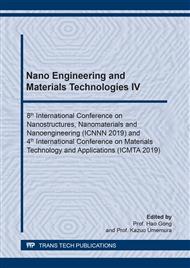p.155
p.161
p.168
p.173
p.177
p.183
p.191
p.197
p.204
Pilot Scale Continuous Adsorption of Soluble Oil Wastewater by Modified Sugarcane Bagasse with Al2(SO4)3 as Adsorbent
Abstract:
The modified sugarcane bagasse with aluminum sulfate was used as an adsorbent for the removal of soluble oil wastewater. The effects of the flow rate, 5 and 10 cm3/min and the number of columns used were thoroughly investigated in a continuous up-flow adsorption process. At the flow rate of 5 cm3/min respected to the 2nd column, the highest breakthrough point to adsorb soluble oil wastewater was at 6 hrs. The results confirmed that the modified sugarcane bagasse can be used as an adsorbent for fixed-bed continuous adsorption of soluble oil wastewater from steel pipe factory. The breakthrough curves were predicted by Yoon-Nelson model. This model may be fitted to predict the overall breakthrough curve using the experimental data gathered. In addition, the significant uptake of the soluble oil wastewater was demonstrated by the changes in the heat of combustion of the modified sugarcane bagasse before and after the adsorption process.
Info:
Periodical:
Pages:
177-182
Citation:
Online since:
May 2020
Price:
Сopyright:
© 2020 Trans Tech Publications Ltd. All Rights Reserved
Share:
Citation:


